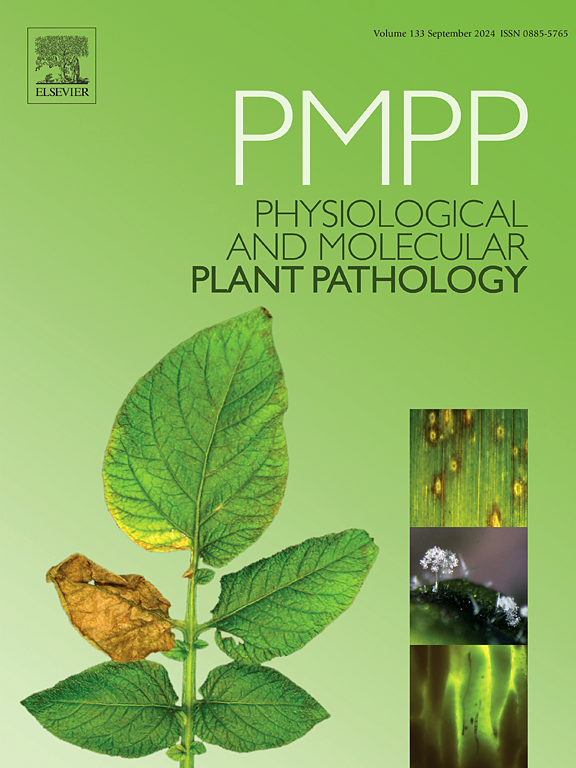Development of specific polyclonal antibodies and a fluorescence-based immunoassay for detecting tomato brown rugose fruit virus- Iranian isolate
IF 2.8
3区 农林科学
Q2 PLANT SCIENCES
引用次数: 0
Abstract
Tomato brown rugose fruit virus (ToBRFV; Tobamovirus fructirugosum) is an emerging virus species within the Virgaviridae family. It poses a significant threat to tomato and pepper production in Iran and worldwide. Managing ToBRFV is particularly challenging due to its stability and the ease of mechanical transmission. An effective strategy for addressing this virus involves employing quick and sensitive diagnostic method to detect its presence before symptoms appear in plants, followed by the eradication of contaminated sources. Additional strategies include serological detection methods and fluorescence-based immunoassays, which require raising antibodies for an immunochemical reaction. The aim of this study was to develop specific polyclonal antibodies against the coat protein (CP) of the ToBRFV-Iranian isolate and to create fluorescence-based immunoassays utilizing green CdTe quantum dots (QDs) to enhance the sensitivity of conventional immunoassays. To achieve this, the coding region of the ToBRFV-CP was optimized for codon usage, then cloned and expressed in the Escherichia coli strain BL21 (DE3) using recombinant DNA technology. The resulting recombinant coat protein was purified and used to immunize two female New Zealand White rabbits with five injections at two-week intervals. Polyclonal antibodies obtained from the rabbit antiserum were conjugated to horseradish peroxidase (HRP) using the periodate method and to QDs using 1-Ethyl-3-(3-dimethylaminopropyl) carbodiimide (EDC) and N-Hydroxysuccinimide (NHS) as chemical linkers. Their characteristics and sensitivity were evaluated through various serological assays. The results indicated that both ToBRFV-CP-IgGHRP and ToBRFV-CP-IgGQDs exhibited high sensitivity in detecting ToBRFV. The concentrations of the antigens (ToBRFV-CP) and the dilutions of the infected extracts identified by ToBRFV-CP-IgGHRP were 250 ng/mL and 1:16, respectively. In contrast, for ToBRFV-CP-IgGQDs, they were 50 ng/mL and 1:32. Actually, compared to traditional immunoassays, the fluorescence-based immunoassays demonstrated two to five times more sensitive. Another finding from the study is the antibodies' ability to distinguish between samples infected with the ToBRFV-Iranian isolate and the closely related tobamoviruses. Additionally, this research represents the first successful report of a fluorescence-based immunoassay for ToBRFV. Also, alignment results of the present isolate with other isolates available in NCBI showed that this isolate has 100 % identity in antigenic regions with isolates from the USA, Jordan, Italy, Lebanon, and Albania. The antibodies could likely detect the mentioned isolates.

番茄褐皱果病毒伊朗分离物特异性多克隆抗体和荧光免疫分析法的建立
番茄褐皱果病毒;果状托巴莫病毒(toamovirus frutirugosum)是处女病毒科的一种新兴病毒。它对伊朗和全世界的番茄和辣椒生产构成了重大威胁。由于其稳定性和机械传动的便利性,管理ToBRFV尤其具有挑战性。应对这种病毒的有效策略包括采用快速和敏感的诊断方法,在植物出现症状之前检测其存在,然后根除污染源。其他策略包括血清学检测方法和基于荧光的免疫测定,这需要提高免疫化学反应的抗体。本研究的目的是开发针对tobrfv - iran分离物外壳蛋白(CP)的特异性多克隆抗体,并利用绿色CdTe量子点(QDs)建立基于荧光的免疫测定方法,以提高传统免疫测定方法的灵敏度。为此,对ToBRFV-CP的编码区进行密码子使用优化,利用重组DNA技术克隆并在大肠杆菌BL21 (DE3)中表达。纯化得到的重组外壳蛋白,每隔两周注射五次,用于两只雌性新西兰大白兔的免疫。从兔抗血清中获得的多克隆抗体采用高碘酸盐法与辣根过氧化物酶(HRP)结合,并以1-乙基-3-(3-二甲氨基丙基)碳二亚胺(EDC)和n -羟基琥珀酰亚胺(NHS)作为化学连接体与量子点结合。通过各种血清学试验评价其特点和敏感性。结果表明,ToBRFV- cp - igghrp和ToBRFV- cp - iggqds检测ToBRFV均具有较高的灵敏度。ToBRFV-CP- igghrp鉴定的抗原(ToBRFV-CP)浓度为250 ng/mL,感染提取物的稀释度为1:16。相比之下,ToBRFV-CP-IgGQDs为50 ng/mL和1:32。实际上,与传统的免疫测定法相比,基于荧光的免疫测定法的灵敏度高出两到五倍。该研究的另一个发现是抗体能够区分感染tobrfv -伊朗分离物的样本和密切相关的多巴胺病毒。此外,这项研究代表了首个成功的基于荧光的ToBRFV免疫测定报告。此外,该分离物与NCBI中其他分离物的比对结果表明,该分离物在抗原区与来自美国、约旦、意大利、黎巴嫩和阿尔巴尼亚的分离物具有100%的一致性。抗体可能检测到上述分离株。
本文章由计算机程序翻译,如有差异,请以英文原文为准。
求助全文
约1分钟内获得全文
求助全文
来源期刊
CiteScore
4.30
自引率
7.40%
发文量
130
审稿时长
38 days
期刊介绍:
Physiological and Molecular Plant Pathology provides an International forum for original research papers, reviews, and commentaries on all aspects of the molecular biology, biochemistry, physiology, histology and cytology, genetics and evolution of plant-microbe interactions.
Papers on all kinds of infective pathogen, including viruses, prokaryotes, fungi, and nematodes, as well as mutualistic organisms such as Rhizobium and mycorrhyzal fungi, are acceptable as long as they have a bearing on the interaction between pathogen and plant.

 求助内容:
求助内容: 应助结果提醒方式:
应助结果提醒方式:


